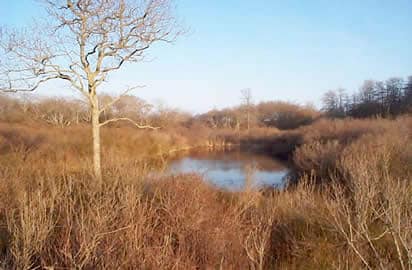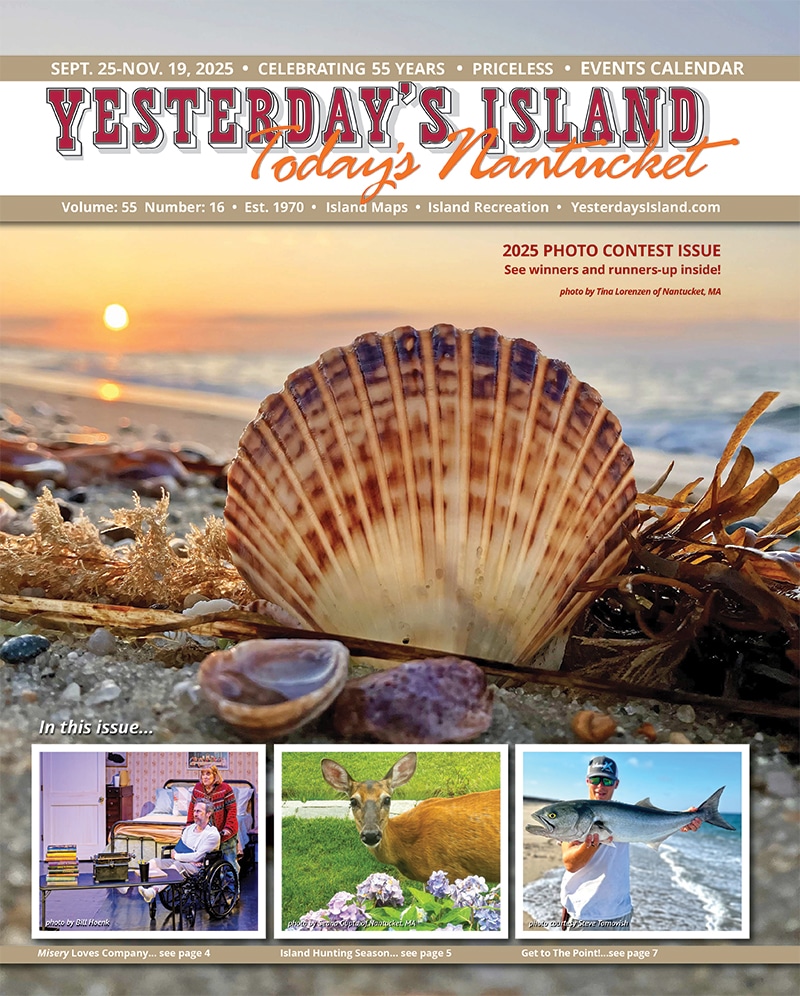• by Dr. Sarah Oktay, Director, University of Massachusetts Nantucket Field Station •
Spring is vernal pond season. All over the island, creatures who have adapted to the unusual conditions that are inherent in a vernal pond are hatching and going through a variety of stages as they progress to become the fairy shrimp, salamanders, frogs, dragonflies, mosquitoes and other aquatic insects they were destined to become. Vernal ponds are temporary pools of water usually created by spring rains, melt-water from ice and snow, freshwater seeps, and groundwater. These ephemeral or fleeting ponds got their name from the Latin word for spring (“vernal”). Some vernal pools can be created by fall rains (autumnal”) and may even persist over the winter although they normally dry completely by the middle or end of summer each year, or at least every few years. Typically they have no natural outlet or stream for water to drain into or out of the system; they are dependent on the vagaries of snow and rain. Because vernal ponds dry up, fish cannot survive in them, so the creatures that make them their home are safe from fish but they have to adapt to drying conditions and the loss of life sustaining fluid. This blooming of creatures from the muddy or dry bottom always remind me of some magical place, and the creatures that live in them have a phoenix-like ability to survive in some cases for years before hatching.
In Massachusetts, vernal pond habitat is currently defined as areas where water is contained for more than two months in the spring and summer of most years and where no reproducing fish populations are present. So the majority of vernal pools are small, shallow ponds characterized by a lack of fish and by periods of dryness. Vernal pool habitat is extremely important to a variety of wildlife species including some amphibians that breed exclusively in vernal pools, and other organisms such as fairy shrimp, which spend their entire life cycles confined to vernal pool habitat. Massachusetts was one of the first states to formally recognize vernal ponds and develop regulations protecting them as special habitats of concern. The Massachusetts Division of Fisheries and Wildlife’s Natural Heritage & Endangered Species Program “Guidelines for the Certification of Vernal Pool Habitat” (http://www.mass.gov/eea/docs/dfg/nhesp/vernal-pools/vpcert.pdf retrieved April 29, 2014) lists a description of the two types of species used along with physical criteria to distinguish a vernal pool. They are: “Obligate Species: vertebrate and invertebrate species that require vernal pools for all or a portion of their life cycle and are unable to successfully complete their life cycle without vernal pools. Facultative Species: vertebrate and invertebrate species that frequently use vernal pools for all or a portion of their life cycle, but are able to successfully complete their life cycle in other types of wetlands.”
According to the Vernal Pool Association (an excellent resource for teachers found at http://www.vernalpool.org/vernal_1.htm ), in New England, the most easily recognizable obligate species are organisms such as fairy shrimp, mole salamanders, and the wood frog. We do not have mole salamanders here but our trusty State Reptiles and Amphibians list (link below) lists Spotted Salamanders (Ambystoma maculatum) and Eastern Red-backed Salamander (Plethodon cinereus) as two species of salamanders that we do have roaming the vernal ponds of Nantucket. Currently, students at the Nantucket Field Station are conducting a survey on the various “morphs” or color varieties (red striped versus gray/black striped) that are exhibited by P. cinereus ( a picture of these color morphs can be found at http://www.new.towson.edu/herpetology/amphibians/Plethodon%20cinereus.htm) . Our primary obligate species on island and at least a runner-up in any “coolest creature” contest is the fairy shrimp. Our primary facultative species (and one of the best ways to find these well hidden ponds) is the spring peeper, our loudest harbinger of spring (a 2009 Yesterday’s Island article on peepers can be found at http://yesterdaysisland.com/archives/science/1-a.php) .
If ever a creature was aptly named, the fairy shrimp [Eubranchipus vernalis and the less common E. intricatus] is it—from their upside down swimming behavior (common for all the species in the order Anostraca) and forked white tails to the delicate manner in which the females protect the encysted eggs in a brood pouch. These inch-long crustaceans, whose diaphanous bodies are tinted in varying shades of blue, orange, or yellow, are as ephemeral as their habitat. The shrimp mate and the females lay eggs that fall to the bottom of the pool. The eggs go into suspended animation when the pool dries out, sitting in the sediment for months or years, if necessary, until the pool fills up again. These eggs can even survive ingestion by animals! Once immersed in water, like magic “sea monkeys,” the creatures come to life, breed and die, all in as few as 15 days.
While the fairy shrimp are around, they serve as an important food source for hungry waterfowl and other birds migrating north during the spring. And yes, the similarities to a “Sea Monkey” or brine shrimp are not accidental. Fairy shrimp (Anostraca) are invertebrates that include brine shrimp (genus Artemia (i.e., “Sea Monkeys” , boxtop not included). There are about 300 known fairy shrimp species. While a few fairy shrimp species live in salty environments (hence the name brine shrimp), the majority of fairy shrimp live in fresh water like our local friends. The fairy shrimp found in vernal ponds on Nantucket in areas like Squam Swamp are orange in color due to a combination of higher levels of hemoglobin created to accommodate and facilitate oxygen transport in water known for lower oxygen levels and carotenoids in the phytoplankton and microscopic detritus they eat. In the spring, oxygen levels are high and the water temperature is cold, but as temperatures increase and the water level drops (and decomposition increases) the oxygen levels drop.
The race to complete all the stages in an organism’s life cycle before the pond dries up is also complicated by a delicate and highly orchestrated dance of larval emergence and development observed in many species of vernal-pond-loving insects, dragonflies, salamanders, frogs, and crustaceans. Each group’s appearance is carefully timed to include optimal egg laying, die off or sequestering in the mud, or haul up on land (or into the sky for the dragonflies and mosquitoes) before their primary nemesis comes along. The fairy shrimp are an excellent example of this as they come out very early in the sequence of larval development and are gone before too many other predators show up. Several species of salamanders are exhibiting die offs that have been attributed to an inability to escape a pond quickly enough in the tadpole stage before a pond dries up prematurely when surrounding trees are cut down that provide shade protection.
Many people believe (for good reason) that the Father of vernal pool protection, certainly in Massachusetts, is Leo P. Kenney. Mr. Kenney is the founder of the Vernal Pool Association and was awarded the 1995 Environmental Law Institute and EPA National Wetlands Award for his vernal pool outreach efforts. His book, now in a third edition and co-written with Matthew R. Burne is “A Field Guide to the Animals of Vernal Pools” (http://www.mass.gov/eea/agencies/dfg/dfw/natural-heritage/publications-forms/publications/) and it is the book to use for identifying animals that live in vernal ponds in the Northeast. Other cool species well documented in the book and lurking in island pools include the caddisfly larvae which drags around a protective casing, predaceous diving beetles (the infamous “toe biters’), mosquito “wrigglers,” (early stages/instars of mosquitoes that roll around like spastic gymnasts), phantom midges, water striders, mayfly and dragonfly larvae, and many other fascinating creatures.
On Nantucket, the Nantucket Land Council has traditionally been the advocate for documenting our vernal pools and they offer excellent vernal pond field classes. Habitat destruction is the major threat to vernal ponds. Often, people mistake seasonally wet areas as unimportant and proceed to fill in or drain these critical habitats. Sometimes landowners believe that by making a vernal pond permanent (by digging it bigger and deeper) they are increasing the value of the area for wildlife. And diverting groundwater for other uses, whether in filling private ponds or by building culverts in areas not suited for them, can lower groundwater areas and permanently dry up these critical resources. Tree cutting and buffer removal takes away two very important defense mechanisms; the lack of shade causes premature desiccation and removal of the leaves means that they are unavailable to provide habitat, hiding spaces, and decaying organic matter to feed the creatures and bacteria in the pools. Vegetated buffer zones around vernal ponds keep silt out of the vernal pond. Excessive silt can fill in a pond and also suffocate the delicate salamander and frog eggs. Sadly, many ponds are filled in, or altered in some way long before they are documented or even known to exist. A vernal pond can be simply a low spot in the summer. It is estimated that in California, perhaps only 7% of the vernal ponds are still intact.
Even of more concern are the lower diversity and incidences of mutation observed in many species of animals that live in these habitats. Amphibians are declining worldwide due in great part to their ability to absorb chemicals and moisture through their skin. Amphibians are indicator species for pollution and vectors that act as early warning systems. And the other creatures that live in vernal ponds are especially susceptible to land use changes and mismanagement and they deserve our protection.
For more information on vernal ponds and the creatures that live there and find out how you can help identify them and protect them, visit http://www.mass.gov/eea/agencies/dfg/dfw/natural-heritage/vernal-pools/ (retrieved April 29, 2014). Enjoy those peepers and our warming spring weather!



